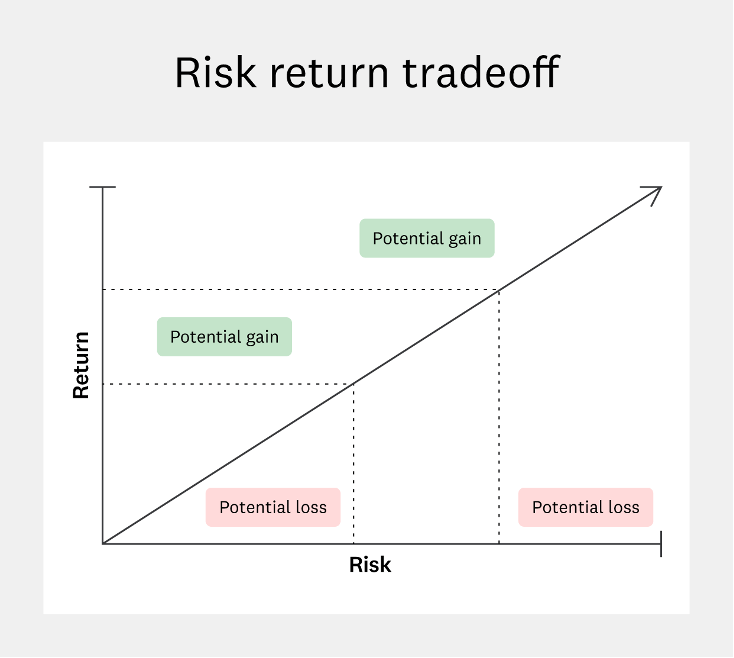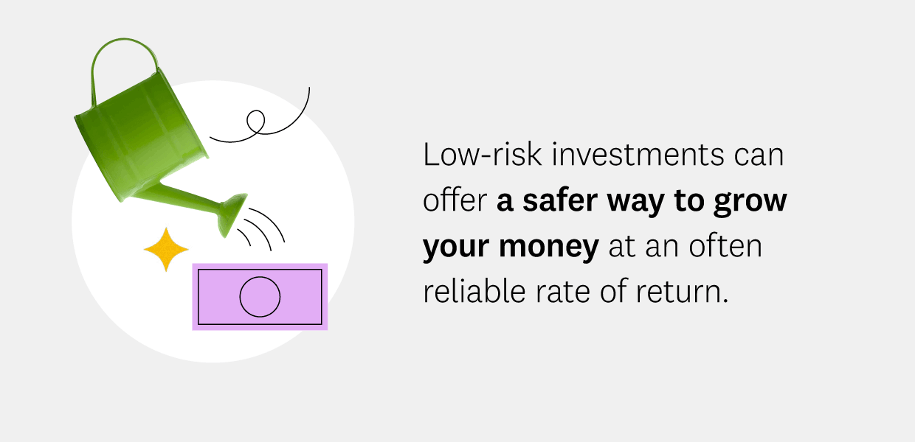In a Nutshell
Low-risk investments may be beneficial for people who want to minimize their loss potential. Examples of potential low-risk investments include money market accounts, certificates of deposit and Treasury bills. But keep in mind that low-risk investments do not guarantee returns, and they may even lose value because of inflation or other risk factors.Investing can seem intimidating, especially when you’re just getting started. You may seek out safer investments during times of uncertainty, and there are a number of lower-risk investment options to consider.
Remember that each investment has its own trade-offs regarding risks and benefits. And more financially rewarding investments may come with more risk. You may be familiar with the idea that riskier investments have the potential for higher returns.
On the flip side, keep in mind that lower-risk investments often have lower yield returns. But that doesn’t mean you don’t have the potential to make a profit from your investments.
We’ll review some common investments to consider below.
 Image: low-risk-high-risk-chart
Image: low-risk-high-risk-chart- High-yield savings accounts
- Cash management accounts
- Certificate of deposit
- Treasury securities
- Money market funds
- Preferred stock
- Fixed annuities
- Dividend-paying stocks
- Stable value fund
- Series I bonds
1. High-yield savings accounts
High-yield savings accounts are similar to your everyday savings account, just but have higher APRs compared to the average account. You can use these accounts for long-term savings goals or to hold extra money from your checking account.
For example, if you want to start saving for a house or building up an emergency fund, this could be a great option.
Flexibility
These accounts are fairly flexible. Since they are savings accounts, you may be limited to withdraw money only up to six times per month.
Cost
Some banks may require you pay a minimum deposit to open an account.
How does it work?
Since your money isn’t locked up in a contract, these accounts are one of the more flexible investment types, assuming you meet FDIC insurance requirements. You can withdraw some of your money as you need it but still potentially earn a profit over a long period due to compounding interest.
2. Cash management accounts
Cash management accounts, also known as sweep accounts, are financial accounts offered by a brokerage firm that combine the abilities of checking accounts and high-yield savings with the ability to move money into investments.
Uninvested money in your cash management account is “swept” into traditional accounts at partner banks, which means some of your money may be FDIC insured.
For example, say you contribute $100 and buy three shares of an ETF at $33 each. You would spend $99 with $1 left in your cash management account.
Flexibility
If your money is in a brokerage account, you can easily move it into an investment account. Most cash management accounts also offer checks and debit cards for easy access to your funds.
Cost
The initial cost of setting up these accounts depends on the brokerage that holds the money. Cash management accounts can come with fees to use the service.
Depending on the provider and how much cash you have to manage, this will differ.
How does it work?
Depending on where your cash is and how much you have deposited, it may be FDIC insured. Depending on your account, you may be able to cash out quickly.
3. Certificate of deposit
A certificate of deposit (or CD) is a fixed amount of money you contribute to savings for a fixed amount of time. In exchange, banks will pay interest to use your money elsewhere during that time.
With this type of investment, you can choose the time period you want to invest for, and the interest rates are usually based on market conditions such as the federal funds rate that the Federal Reserve sets.
Flexibility
As most banks expect to hold your money for that fixed time frame, it isn’t usually advantageous to withdraw your money sooner than expected. You may face different fees depending on your bank’s guidelines.
Cost
You can choose the amount you would like to contribute to a CD (though there might be a minimum required), and there typically isn’t a cost specifically associated with opening a CD.
Remember that most CDs will automatically renew unless you instruct the bank or credit union not to. If you want to use your cash for something else, check with your bank before your contract is up.
How does it work?
If a CD is purchased through an FDIC-insured bank, it can be insured for up to $250,000. Keep in mind that this covers all accounts in your name at a specific bank, so if your total account balances at one institution add up to more than $250,000, you may want to consider moving some of that money elsewhere.
4. Treasury securities
Treasury securities are debt obligations in the form of Treasury bills, notes and bonds issued by the United States Department of Treasury. This income may be exempt from state and local taxes (but not federal).
Flexibility
The flexibility of treasury marketable securities depends on the type:
- Treasury Bills — These securities have term options ranging from four weeks to 52 weeks. You can buy them either at face value or a discount, but you’re paid face value when they mature.
- Treasury Notes — These notes mature in terms of two, three, five , seven and 10 years, and interest is paid every six months.
- Treasury Bonds — These come in 20-year and 30-year terms and also pay interest every six months.
Cost
Each of these three types of Treasury securities can be bought in amounts between $100 and $10 million, in increments of $100.
How does it work?
You can buy Treasury marketable securities through a TreasuryDirect account or through a broker.
Keep in mind that TreasuryDirect is only for non-competitive bids, while brokers can be used for either competitive or non-competitive bids.
5. Money market funds
Money market funds are a type of mutual fund that are available to consumers and commercial investors. Not to be confused with money market accounts, these funds are not FDIC-insured.
Flexibility
You can cash out these investments, but it normally comes at a cost. You may have to pay liquidation fees and wait to get your earnings for a fixed time period.
Cost
Money market funds typically don’t require high initial investments. But they’re considered very low risk and aren’t necessarily the best option if you want greater investment gains.
How does it work?
Money market funds are short-term investments that store your money in relatively safe accounts like CDs and Treasury securities. You can think of these funds as a way to further diversify your low-risk portfolio.
6. Preferred stock
Investing in preferred stocks is what its name implies: You have some preferred benefits compared to owners of common stock.
For instance, you may …
- Receive dividend payments before common stockholders
- Be prioritized above common stockholders if the company becomes bankrupt and needs to liquidate assets
- Have priority to invest in future funding rounds
- Have some voting or approval rights for company directors or major transactions
Flexibility
You can sell your preferred stock similar to common stock, but you may face a price decrease or increase since you purchased stock.
Preferred stocks are similar to bonds because they typically provide a fixed rate for income. Some preferred stocks also come with a conversion option. This is where a company buys back the preferred stock from you or converts your stock to common stock.
Review the details of any preferred stock before you buy, and consult a financial adviser if necessary.
Cost
Keep in mind that buying preferred stock will likely cost more than buying common stock for the same company.
Plus, stocks will likely have transaction fees when you buy or sell.
7. Fixed annuities
An annuity is a type of insurance contract that guarantees income to the purchaser over a specified period. There are many types of annuities, and they can vary in structure and price.
Although there are several types of annuities, a common one is a fixed annuity. With these, you pay into the fund over a period of time, and in return, they eventually earn a steady income stream, either over a fixed period or an indefinite one (like the remainder of your life).
Flexibility
Each annuity product is structured differently. It’s advisable to carefully review the contract and the details with a trained professional before purchasing.
Since there are many types of annuities, there are products that are structured better for some individuals than others. For example, in addition to fixed annuities, there are immediate annuities, which allow you to give an insurance company a sum of money in exchange for quickly receiving payments.
Remember that variable annuities often have substantial surrender charges that apply if you take out money within a certain time period of opening the account. These typically last between six and eight years but may extend up to 10 years.
Cost
Keep in mind that if you terminate your contract, you may face a number of fees in addition to taxes and miss out on interest payments.
 Image: watering-can-risk
Image: watering-can-riskOther investments to consider
8. Dividend stocks
Dividends are payments that companies make to shareholders out of part of its profits. Companies that offer regular stock dividends may make good investments for people who are comfortable taking on some more risk while still looking for a relatively stable investment.
Many investors choose dividend-paying stocks to generate a steady income stock prices may not have to increase for the investor to make money due to the dividend payments.
9. Stable value fund
Stable value funds may be a good low-risk investment option for people looking to build wealth over time. Stable value funds may provide investors with a steady return while avoiding the volatility of higher-risk investments.
These funds are typically a mix of bonds and other fixed-income investments, which typically offer higher yields than money market funds without the extreme fluctuations of stock market investments.
They’re ideal for people who are looking to build wealth in the long term without taking on significant risk. Additionally, these funds typically come with contractual guarantees, further protecting investors from potential losses.
10. Series I bonds
Series I bonds protect your purchasing power by allowing you to shield your savings from inflation. They are backed by the full faith and credit of the United States government, so your principal and interest are guaranteed. Series I savings bonds rates change with inflation and are set twice a year.
The interest rate is composed of an inflation-adjusted fixed rate and a variable rate index. The variable rate is based on the average 12-month CPI-U (Consumer Price Index for All Urban Consumers).
Series I bonds have a minimum purchase price of $25 electronically and you can redeem them after 12 months but you will forgo the last three months of interest if you redeem the bonds sooner than five years.


